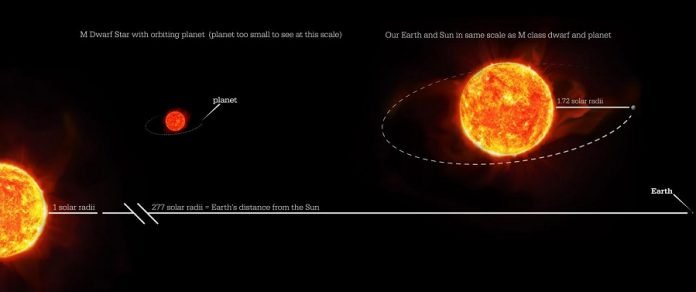
The planetary nature of a Mars-sized object orbiting extremely closely to an M-dwarf star has been validated using the Penn State Habitable-zone Planet Finder (HPF).
The planet, which was originally classified as a false positive in an automated search of data collected by the Kepler space telescope, is about half the size of Earth and is so close to its host star that it orbits in less than 10 hours.
If it were orbiting a star the size of our sun it would be skimming the star’s corona — the aura of exceedingly hot plasma that extends out beyond the star’s surface.
It is the smallest planet with an ultra-short period orbit known and could help astronomers understand how these rare planets form.
A paper describing the discovery, by a team of researchers led by Penn State scientists, appears online and has been accepted for publication in The Astronomical Journal.
“Ultra-short period planets — planets with orbital periods less than one day — are extremely rare,” said Caleb Cañas, a graduate student in astronomy and astrophysics at Penn State and lead author of the paper.
“Only a handful have been detected orbiting M-dwarf stars, which are small, cool stars a fraction of the size and brightness of our sun. We don’t yet know precisely how these planets form, so discoveries like these are important for helping us to constrain potential formation scenarios.”
The Kepler space telescope searched for exoplanets — planets beyond those in our solar system — by observing stars in a large region of the Milky Way galaxy.
It looked for tiny dips in the brightness of stars that could indicate that a portion of the star’s light was being blocked by a candidate planet passing in front of the star during its orbit.
How long the dip in brightness lasts is an indication of the separation between the candidate planet and the host star, and indicator of if the planet might be habitable. These dips in brightness, called transits, would then be vetted by an automated system to identify potential false positives.
Kepler observed such a dip in the brightness of the M-dwarf star KOI-4777, but the dip was so brief that the automated vetting originally suggested it to be a false positive.
A new statistical analysis technique developed by Eric Feigelson, Distinguished Senior Scholar and professor of astronomy and astrophysics and of statistics at Penn State, and his team of astrostatisticians, independently detected this planet at its correct period in the Kepler dataset.
Later, a manual check of potential false positives in the Kepler data determined that the dip in brightness of KOI-4777 did in fact represent a potential planetary system with an orbital period of 0.412 days, or about 9.9 hours.
“We used the Habitable-zone Planet Finder, a high-precision astronomical spectrograph installed on the Hobby-Eberly Telescope at the McDonald Observatory in Texas to observe this system,” said Suvrath Mahadevan, professor of astronomy and astrophysics at Penn State and an author of the paper.
“Given how close this planet is to its host star, it is unlikely to be habitable, but we knew from the start that we would be able to learn about much more than just habitable planets with the HPF. The precision of the HPF allowed us to statistically validate the planet, known as KOI-4777.01, and begin to characterize its properties.”
Planets orbiting stars exert a tiny gravitational pull that causes the star to wobble. This wobble results in tiny shifts in the wavelength of light emitted by a star as a result of the Doppler effect, just like how the pitch of the siren on an ambulance changes as it speeds by you.
HPF is designed to detect these slight shifts in wavelength in near-infrared light emitted by M-dwarf stars.
“With the precision of the HPF spectrograph we are able to validate that KOI-4777.01 is indeed a planet by eliminating other potential sources of the signal, such as additional planets or nearby stars,” said Cañas.
“Although we can’t yet determine the mass of the planet, we can constrain it to a maximum of about a third of the Earth’s mass — its mass if it was entirely composed of iron, the densest material from which we would expect a planet to naturally form.
This makes it the smallest ultra-short period planet observed to date. Discovering additional such planets will be important for understanding how these rare planets form.”
Written by Sam Sholtis.



